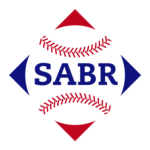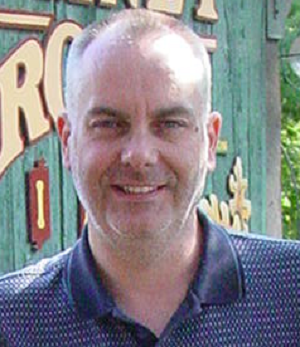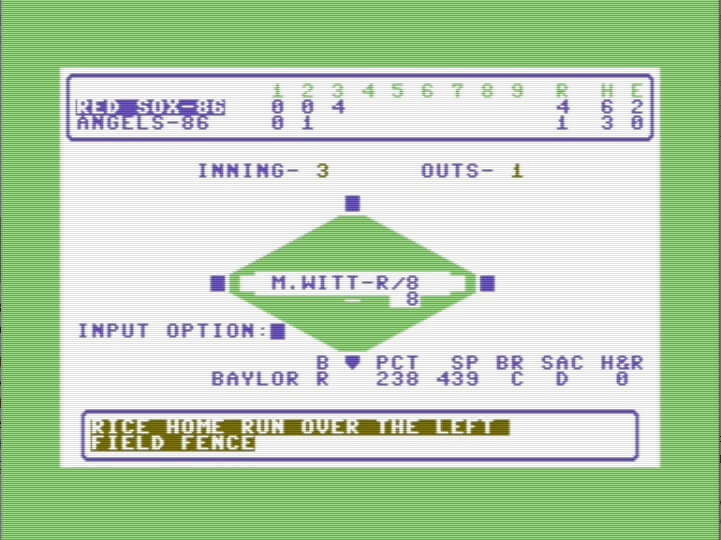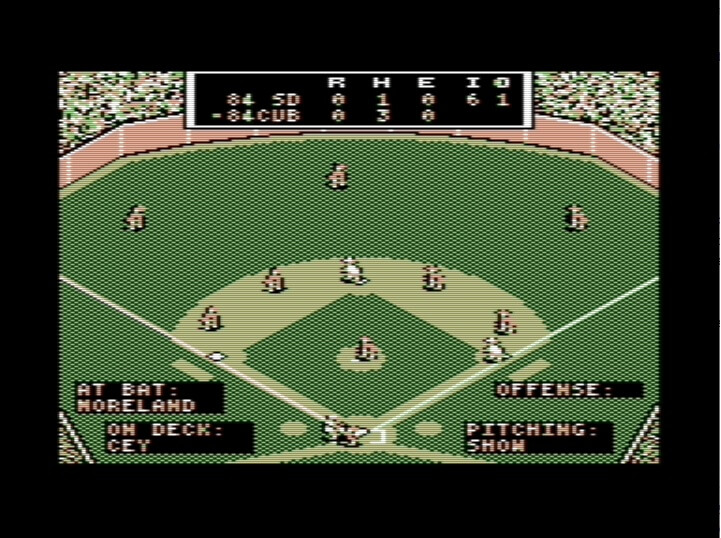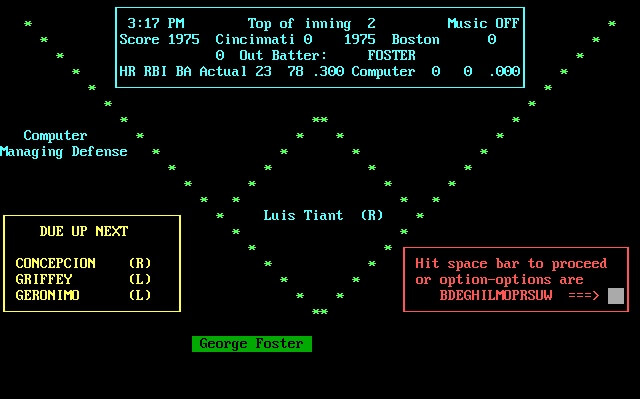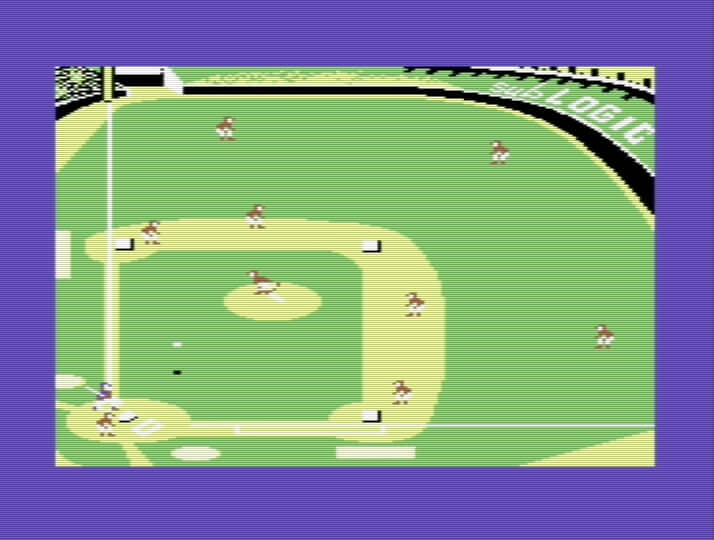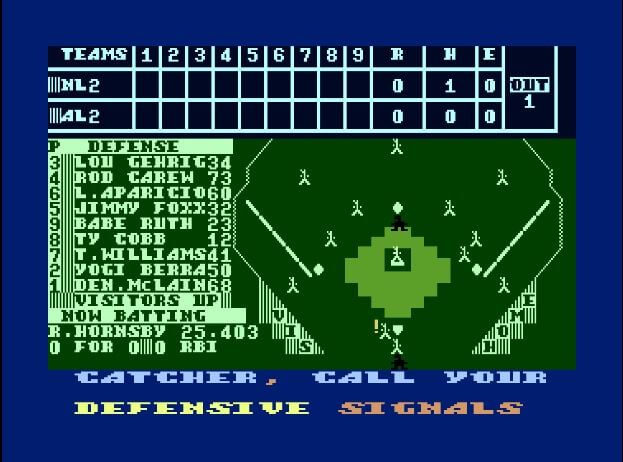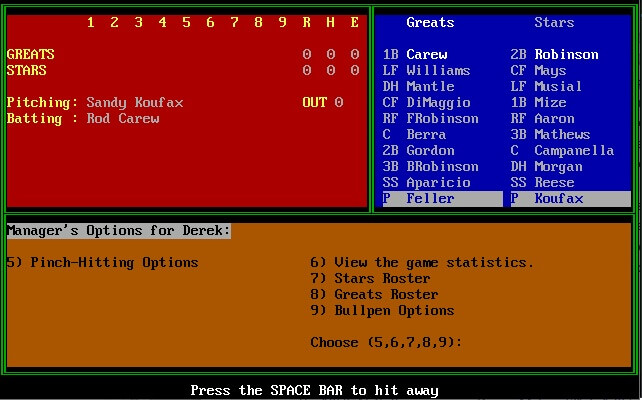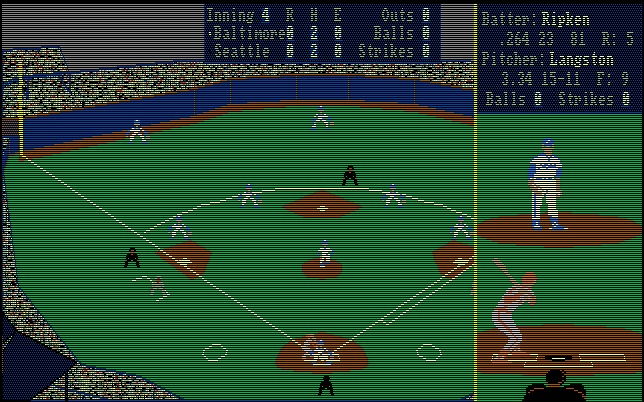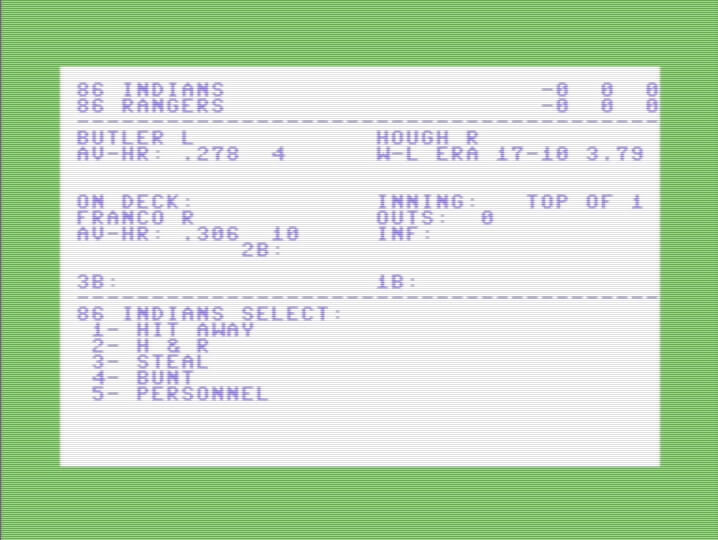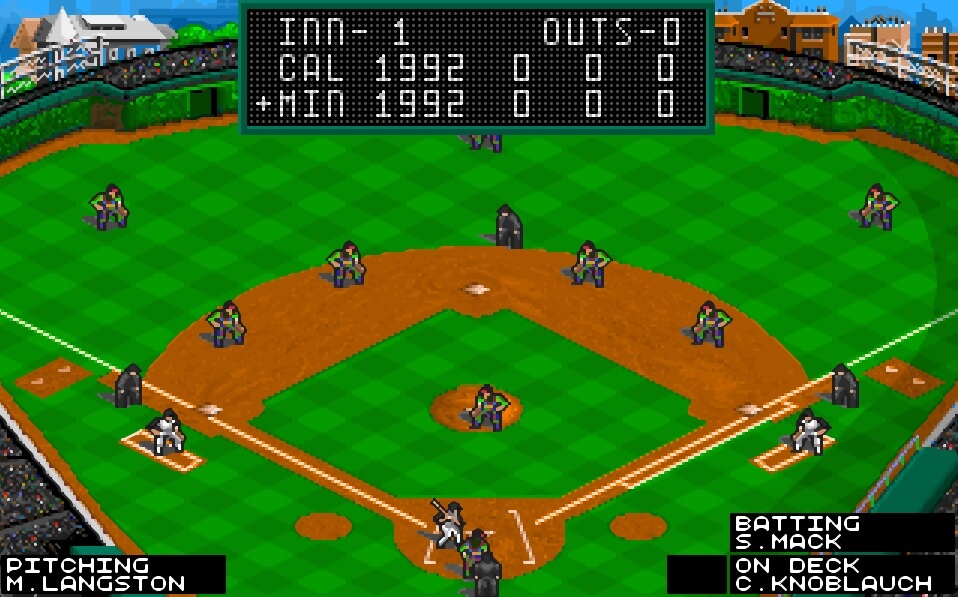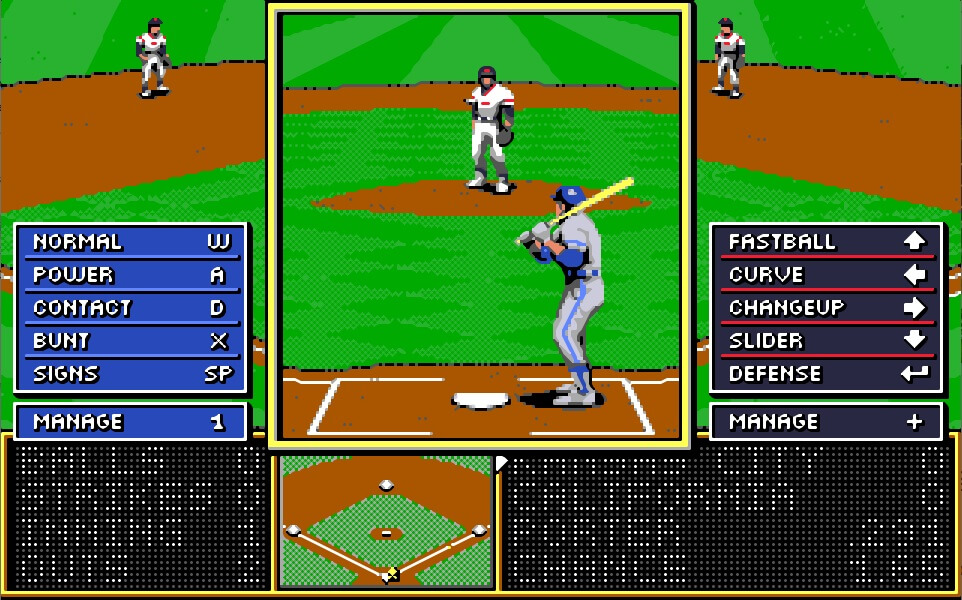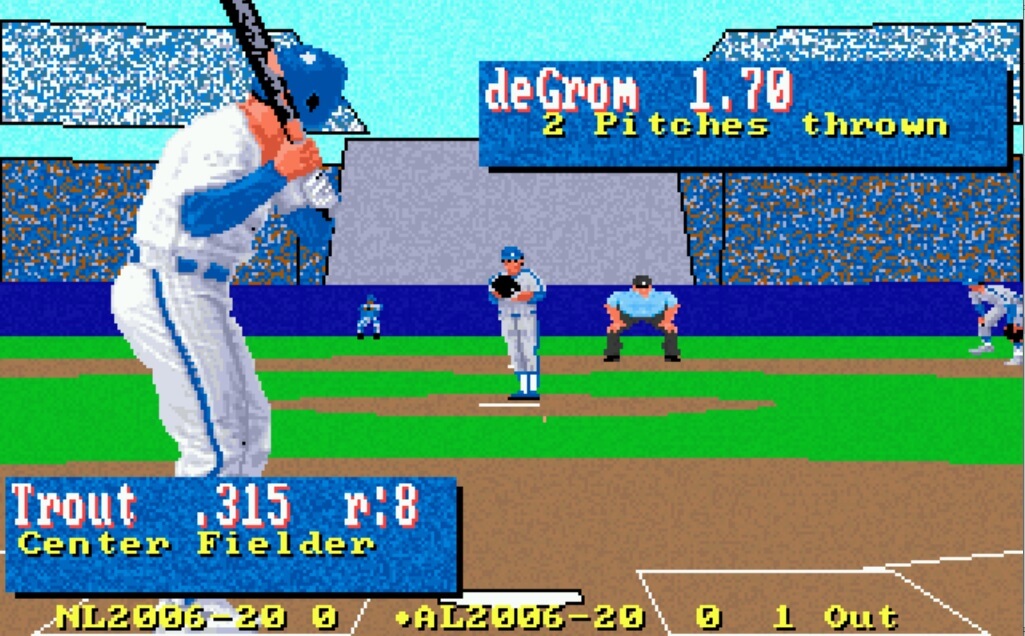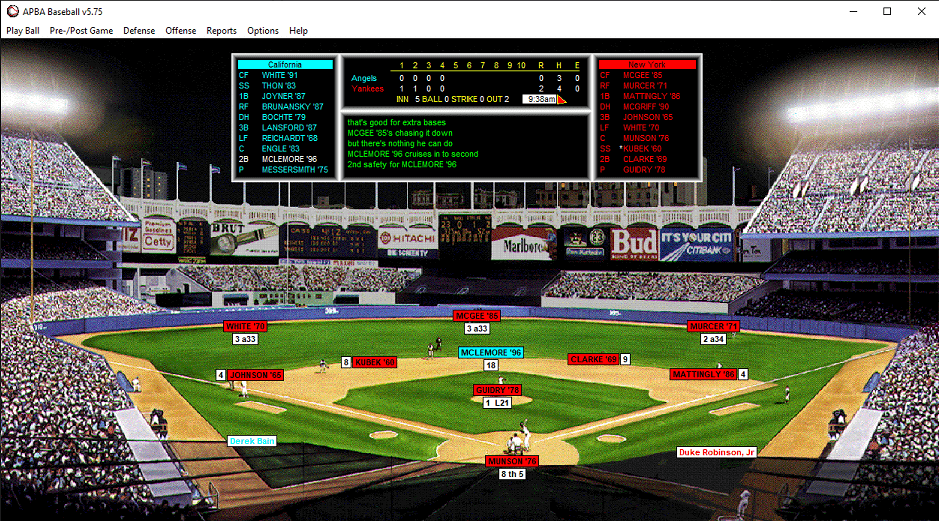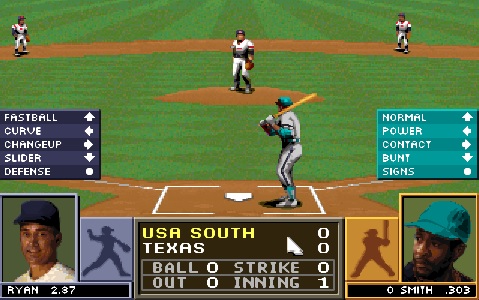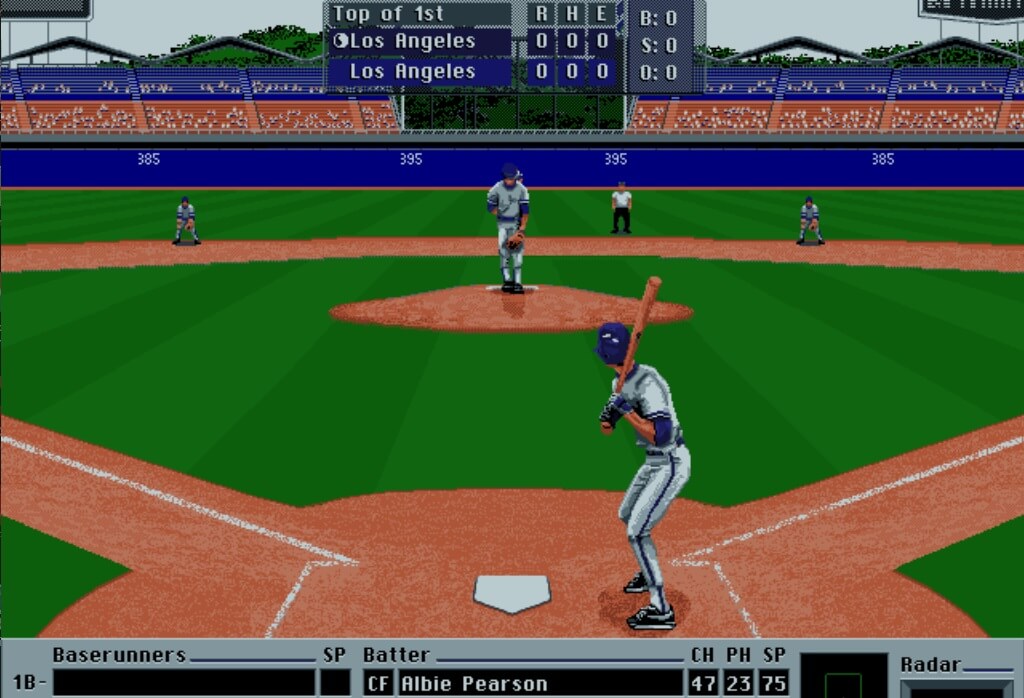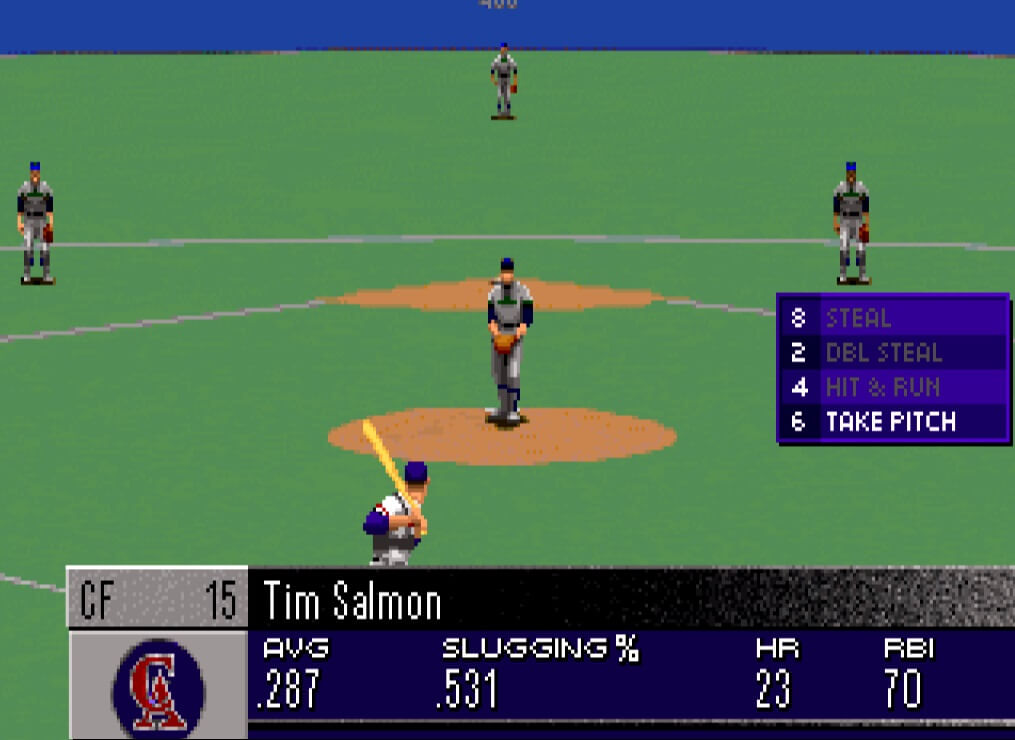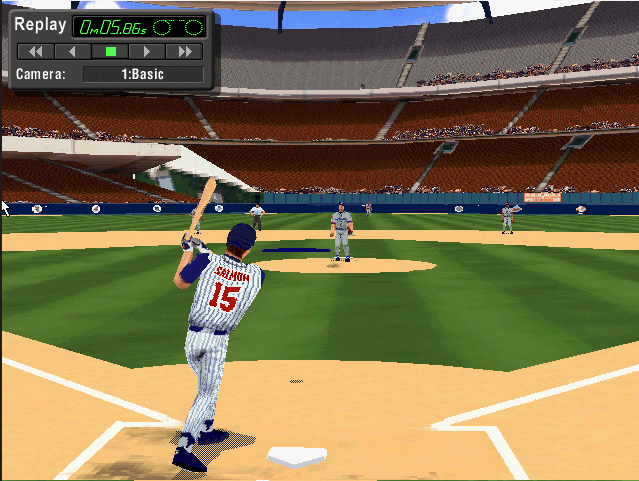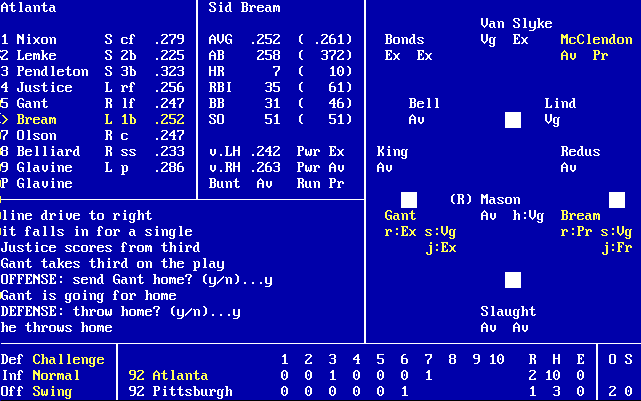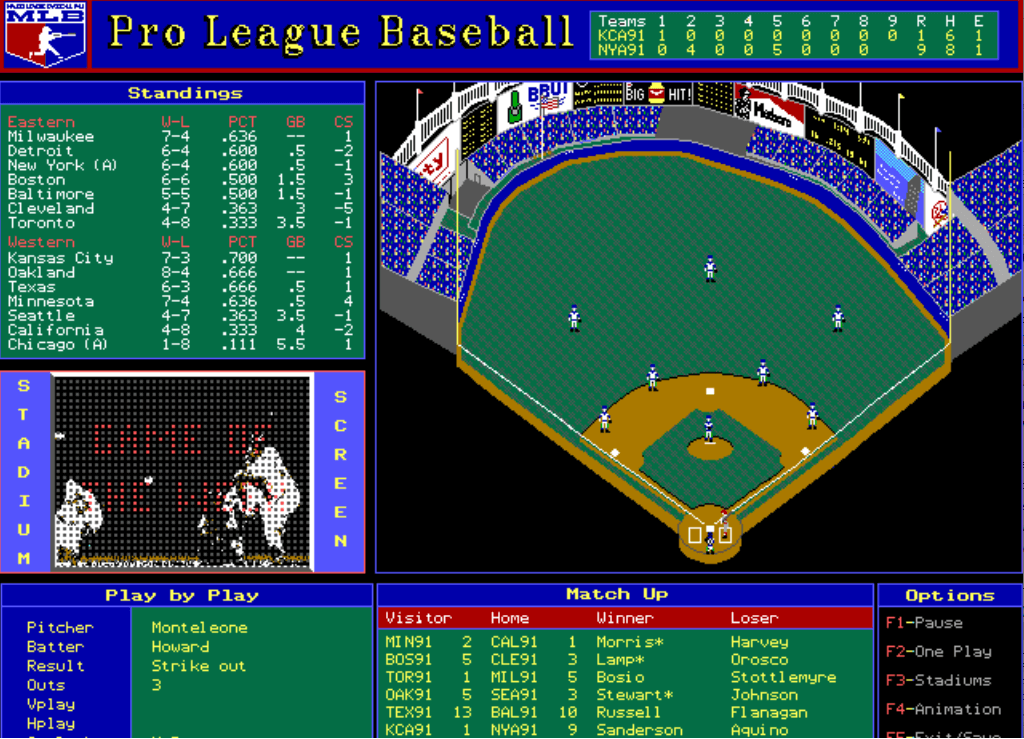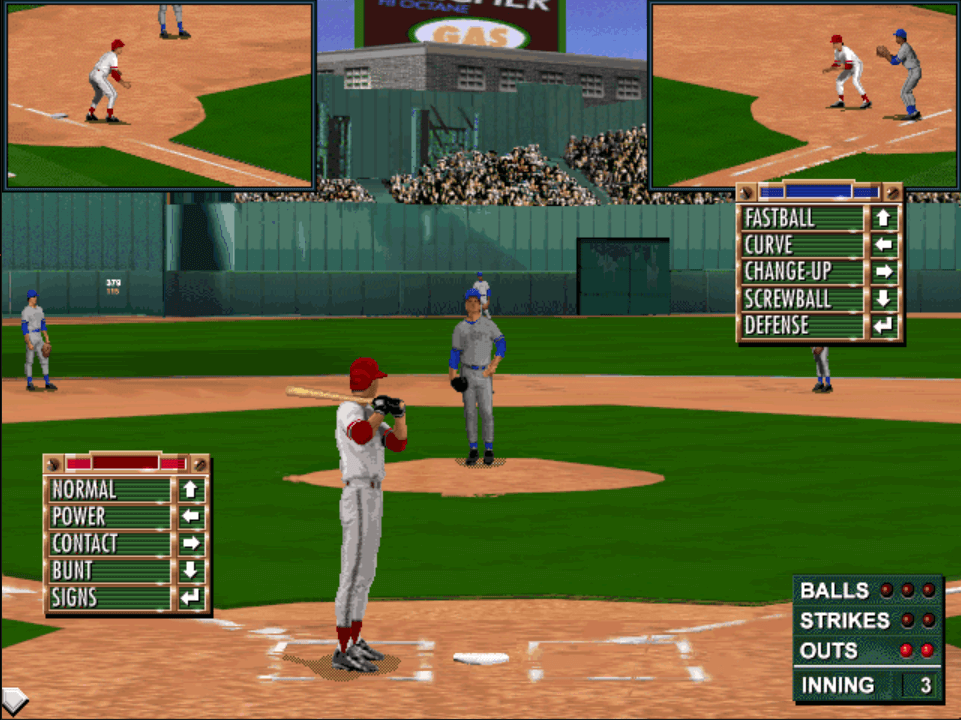This is the first entry in a series focusing on computer baseball simulations to supplement the chapter “Play Retro Baseball Video Games In Your Browser” from my Hardball Retroactive book along with the corresponding post at Hardball Retro. The series will focus on baseball simulations – games in which the primary emphasis is on managerial strategy and the ability to replay entire seasons with a degree of realism. Baseball video games that are strictly arcade representations of baseball (based solely on reflex and hand-eye coordination) are excluded.
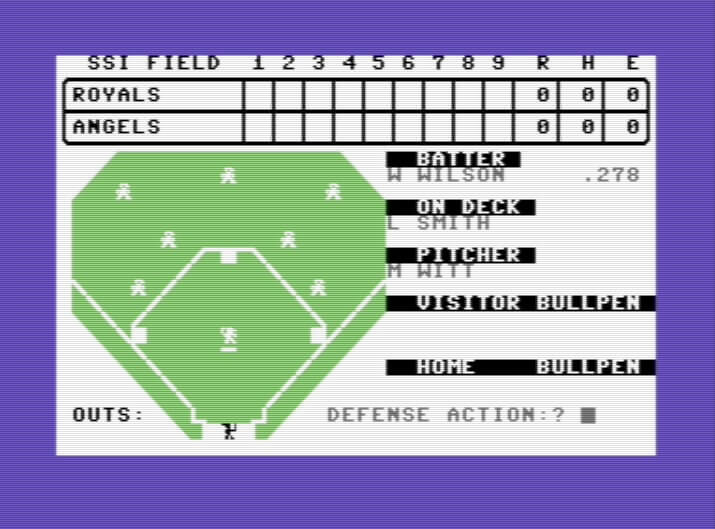
Publisher – Strategic Simulations Inc.
Release Year – 1981
Platforms – Amiga, Apple ][, Atari 8-bit, Commodore 64, IBM PC, Macintosh
Credits
| Game Design & Programming: | Charles Merrow and Jack T. Avery |
| Programming (C64 Version): | Roy Wagner |
| Game Development: | Joel Billings |
| Customized Disk Operating System: | Roland Gustafsson |
| Play Testers: | Trip Hawkins, Frank Pellegrini, Rick Spinelli |
| Art & Graphic Design: | Louis Hsu Saekow, Kathryn Lee, James C. Sommerville |
Interview
Joel Billings founded Strategic Simuations Inc. (SSI) in 1979. The company published over 200 games spanning more than 15 years in the industry. Although SSI primarily focused on war games and role-playing games, they figure prominently in the development of early microcomputer sports sims (Computer Baseball, Computer Quarterback) and published two games in the Tony La Russa Baseball series. I contacted Joel and he responded to a series of questions about Computer Baseball.
DB: How was the original design of Computer Baseball conceived and what was your role?
JB: Charlie Merrow and Jack Avery, IIRC, were the designers of the game. They had done a wargame for SSI in late 1980, Computer Air Combat, so they were already familiar with the Apple II computer. I don’t remember, but assume they were baseball fans and talked to us about making a baseball game. As a former Strat-o-Matic board game player (of their baseball, football and basketball games), I’m sure I was as interested as they were. We had previously released Computer Quarterback so we knew that sports games have a larger market than wargames. As with all SSI games in those early years, I was the game developer/producer for the game. So I oversaw the testing and development of the game, as well as worked on the marketing of it.
DB: This was among the earliest titles published by SSI. What was your prior game development or programming experience?
JB: I started SSI during the summer of 1979, and we published 6 games in 1980. I was a long time board game player, and had used large computers in college. I didn’t see my first personal computer until May 1979 a few weeks before I graduated college. IIRC, Charlie and Jack were friends that worked at the same company. I think it was a defense or aerospace company in the San Diego area. IIRC they were engineers and programmed the games for fun.
DB: Did you take any computer programming courses in high school or college?
JB: I took one BASIC computer class in college in 1976 (a fluke pick-up 6 weeks into the semester when I needed to drop a Probability class I was struggling in). It was the only computer class my college offered. As a quantitative econ major, I used computers a lot in college and my internship at Amdahl in Silicon Valley. It was my summer job at Amdahl after college that put me in Silicon Valley the summer of 1979.
DB: I have the original Commodore 64 version. I am aware that several enhancements including Stat Compiler and Season Disks were released over the next 5+ years. Was a sequel to Computer Baseball ever under consideration?
JB: Not that I remember. After Charlie and Jack did a game called Fighter Command on the Battle of Britain, but that was the last game that I remember they worked on. I don’t know what happened to them. In 1991 we released Tony La Russa Baseball, and 2 years later Tony La Russa Baseball II.
DB: Are you still in contact with any of the other individuals involved with the design, development or testing of Computer Baseball?
JB: No, I haven’t had any contact with them in over 30-35 years.
DB: Were any features scaled back or omitted due to budgetary, compute power, or time constraints? Were those features considered in later editions?
(assuming the Stat Compiler disk falls into this category)
JB: I don’t remember. I’m not exactly sure why we didn’t put the modern players into the original game, but probably given the Strat-o-Matic system of selling player cards by season, we probably assumed from the start we’d do the same thing.
DB: Computer Baseball focused on the gameplay and the engine as opposed to graphics and sound. Are the results for each play determined by random “dice” rolls or similar method? Is the algorithm based on any specific tabletop baseball game or developed on-the-fly specifically for this project?
JB: Again, I don’t remember any of the details. I’m not sure I ever knew the details, so you’d have to find Charlie or Jack to get an answer to that. Since I would guess they are about 20 years older than me, they’d probably be in their 80s now.
DB: Nearly a decade after the release of Computer Baseball, SSI published several of the Tony La Russa Baseball games. What were your impressions of the La Russa series along with the competition as it evolved from Computer Baseball to games such as MicroLeague and Earl Weaver Baseball which incorporated major improvements in graphics, sound, play-by-play and statistical capabilities?
JB: Tony La Russa which was designed by Don Daglow/Stormfront Studios was intended to compete with Earl Weaver Baseball, and thus had to step up the graphics. AFAIK, we were able to successfully compete with Earl Weaver Baseball back then, and Tony La Russa I and II were very good sellers for us. The founder of Electronic Arts, Trip Hawkins, was on our board of directions from 1979 to sometime in late 1981/early 82 when he left to start EA. As a designer of a stat based football game in college, I remember he loved playing our sports games. Not surprising that EA Sports became such a big part of EA’s success. When we did Tony Baseball, it was actually distributed by EA as we were then an affiliated label of EA (and they then owned 20% of SSI). So they were distributing both Earl Weaver and Tony La Russa Baseball, probably the 2 best sellers at that time.
DB: Are you currently working in the computer / gaming industry?
JB: Yes, in 2000, Gary Grigsby, Keith Brors and I formed 2by3 Games to design computer wargames. We publish our games through Matrix Games, and we are still designing and releasing games (last one was War in the East 2).
DB: Do you have any interest in reviving Computer Baseball on a current platform?
JB: No, we just focus on wargames. Besides, the sports market now is so advanced it’s like making a movie to make a sports game (very expensive).
DB: If there are any important points about SSI Computer Baseball that I’ve missed, please share your thoughts here!
JB: We never licensed the player names or stats, and surprisingly no one ever contacted us about it. I didn’t know anything about licensing back then. By the time of Tony La Russa Baseball we understood that licenses had to be obtained, but back in 1981 the computer industry was so small that no one in Major League Baseball ever gave us a thought.
Review
The first electronic baseball simulation available to the masses, Computer Baseball by SSI accurately replicated the decision-making processes offered to tabletop baseball card and dice game “managers” while introducing the artificial intelligence of the computer skipper, “Casey”. I fired up the game on my Commodore 64 emulator. After the intro screen loaded, I examined the main menu and immediately noticed the absence of a computer vs. computer mode. Among the five choices are 1- and 2-player modes, enter data for a new team, edit / review existing team data file, and demo game. I opted for single player mode and selected the teams, lineups and starting pitchers.
I played a 3-game series (Royals-85 at Angels-85) using the Commodore 64 edition to reacquaint myself with the software and run through the various options.
The first game pitted Royals ace and 1985 AL Cy Young Award winner Bret Saberhagen (20-6, 2.87) against Angels Mike Witt (15-9, 3.56). In the bottom of the second inning, Bobby Grich tripled to right-center and scored the first run of the game on a sacrifice fly by Ruppert Jones. The Royals responded with a run in the top of the third when Steve “Bye Bye” Balboni ripped a single to left field to plate Willie Wilson. Doug DeCinces led off the bottom of the 7th with a round-tripper to deep center field, giving the Halos the advantage, 2-1. Saberhagen pitched brilliantly on the losing end, yielding 3 hits over 8 innings, but Witt matched him and Donnie Moore notched the save.
Game 2 featured southpaw Charlie Leibrandt (17-9, 2.69) and sophomore right-hander Ron Romanick (14-9, 4.11). Willie Wilson led off Game 2 with a sharp single to right field and advanced to second on a Lonnie Smith groundout. George Brett followed with a base hit to right, but Juan Beniquez cut down the fleet-footed Wilson at home plate. A similar sequence in the top of the third (with Smith sacrificing Wilson to second) netted the Royals their first run. In the home half of the sixth, Brian Downing and Rod Carew delivered back-to-back singles, placing runners at the corners with no outs. Bobby Grich lifted a shallow fly to left but the runners were unable to advance. Doug DeCinces lined a single to the left-center field gap, scoring Downing and sending Carew to third. Leibrandt avoided further damage and contest remained knotted at one run apiece heading into the 7th inning. Gary Pettis walked with 2 outs and advanced to third on a wild pickoff throw. Downing grounded out to shortstop Buddy Biancalana to quell the threat. Stewart Cliburn entered the game to start the eighth inning, confronting the top of the Royals lineup after Romanick scattered 6 hits over 7 innings. Cliburn retired six of the seven batters he faced while Leibrandt continued to deal into the ninth frame. Bob Boone singled to center field with 2 outs in the ninth, and Casey summoned Dan Quisenberry to the mound. I pinch-ran Rob Wilfong for Boone and batted Ruppert Jones for the Angels shortstop Dick Schofield. Then Casey substituted lefty Mike Jones for Quisenberry, a move that should not have been permitted to occur as the MLB rules state that a pitcher must face at least one batter. The Jones vs. Jones matchup concluded with a line out to first base, and the contest proceeded to extra innings. I relieved Cliburn after 2 scoreless innings with fellow right-hander Doug Corbett. I was not prompted to correct my lineup (I had Jones and Wilfong playing out of position), so I had to adjust this after realizing my mistake and pitching to Jorge Orta. Jerry Narron replaced Wilfong, catching and hitting seventh in the lineup while Craig Gerber came on to play shortstop and bat eighth. Hal McRae pinch-hit for Biancalana with one down in the top of the tenth and coaxed a base on balls. Wilson bunted towards first base but Carew gunned down McRae at second for a fielder’s choice. Kansas City had the go-ahead run at second after Wilson swiped the bag. Corbett whiffed Smith to snuff out the rally. Downing laced an opposite-field double to right with one out in the bottom of the tenth. Casey elected to walk Carew intentionally then brought Steve Farr into the game to face Grich and DeCinces. Both veterans stranded the runners with fly outs to left field. Corbett retired the heart of the Royals order in the top of the eleventh. Joe Beckwith and Rafael Lugo trotted in from the bullpen for their respective teams as the duel marched past the twelve frame. After the Royals designated hitter Jorge Orta doubled with 2 outs in the 12th, I noticed that Hal McRae remained in the lineup. Unable to view my opponent’s defensive orientation, I could only surmise that the 39-year-old was playing shortstop as Biancalana’s replacement, even though Casey had a healthy Onix Concepcion on his bench. Lugo struck out McRae, and we continued to the bottom of the twelfth. Pettis started the inning with a walk, then stole second. Beckwith issued a free intentional pass to Downing, bringing Carew to the dish with no outs and runners on 1st and 2nd.The Royals turned a 4-6-3 double play (nicely executed by full-time DH turned shortstop!) Another intentional walk to Grich gave DeCinces a chance to be the hero. The Halos third-sacker drilled a single that landed in front of left fielder Darryl Motley and the Angels triumphed 2 to 1.
Kansas City struck first in Game 3, as George Brett socked a two-out, two-run blast in the third inning off Don Sutton (15-10, 3.86). Danny Jackson (14-12, 3.42) limited California to one safety through 6 innings. Dane Iorg misplayed Bob Boone’s single to left to begin the seventh, so the backstop trudged over to third base. Gary Pettis grounded into a double play following an intentional pass to Dick Schofield, scoring Boone with the Halos’ first run. Jackson continued his masterful effort through 8 2/3 innings when Boone lined a single in front of center fielder Willie Wilson. Casey visited the mound and brought in his ace reliever, Dan Quisenberry. I selected Rob Wilfong as the pinch-runner for Boone and selected Ruppert Jones off the bench to hit for Schofield. Jones crushed Quiz’s offering into the right-field seats for a walk-off, 3-2 victory to sweep the Royals!
Ratings
Graphics – [1] The bare essentials… The in-game display consists of a scoreboard at the top of the screen, a generic baseball diamond on the left and pertinent information on the right (batter, on-deck, pitcher, bullpens and action prompt). Character graphics are utilized to depict the ballplayers. A white dot representing the ball moves in a straight line (there are no fly ball arcs or shadows to assist with illustrating the ball in flight. Fielders move immediately to intercept the ball. Baserunners are denoted only by their runner rating, a number from 1 to 9 pasted on top of the base that they currently occupy.
Sound – [1] The lone sound effect in the Commodore 64 edition was the crack of the bat.
Strategy – [3] The documentation includes strategy cards for Defense and Offense Options. Prior to throwing the first pitch to the current batter, the user is prompted to enter the Defense and/or Offense action, depending on the number of players (1 or 2). The defensive options consist of actions taken against the current batter (pitch to the batter, pitch around or issue an intentional walk), setting the infield and outfield depth, and whether or not to hold the baserunners. Visiting the mound (VM) and bullpen change (BP) allows you to warm up pitchers, check their status or bring them into the game. The Change players (CP) option facilitates lineup modifications. A glaring omission is the inability to call for a pitchout. On offense, the manager can advise the batter to swing away, hit and run, or bunt. The baserunner(s) can be given the green light to steal and there are 3 options instructing the advancement of runners on a base hit (run normally, conservatively or aggressively). You can decide to pinch-hit or pinch-run along with handling the bullpen (relievers continue to “warm up” while your team is batting). Lastly, there is the ability to save the state of the game in progress. You can resume the game at a later date after choosing the number of players at the main menu (you’re asked if you wish to play a new game or resume a saved game).
Artificial Intelligence – [3] In a 1-1 game in the bottom of the 7th with runners on 1st and 2nd with no outs, Casey sent Hal McRae to pinch-hit for the Royals shortstop, Onix Concepcion (.204). McRae promptly bunted into a 1-6-3 double play. Omar Moreno struck out to end the threat, stranding Jim Sundberg at 3rd base. Later in the same contest, Jorge Orta was caught stealing second base to end the game, leaving McRae dumbfounded at the dish. However, the vast majority of in-game substitutions and tactical decisions were conducted appropriately.
Box Score – [1] You are given the option of printing the box score to the screen or printer. After posting the line score for the contest, the visitor’s box score appears. I immediately noticed that the results do not match the actual lineup order. Instead the order is based on defensive positioning. Omitting the pitcher (1), the Royals box score begins with Jim Sundberg (2 – catcher), Steve Balboni (3 – first baseman), etc. I’m not sure why the programmers chose to ignore the standard box score format as this presentation leads to confusion. Several standard statistics are omitted from the box score, including wild pitches, passed balls, saves and double plays.
Rosters [1] – Each team consists of a 25-man roster (15 batters and 10 pitchers). There are no reserves. My version came with the rosters from the 1985 season. The 1986 SSI catalog lists team disks from 1980 through 1984 along with “305 Computer Baseball Teams” encompassing every pennant and division winner from 1900 through 1979 (see page 10).
Statistics [2] – Most of the standard (pre-Sabermetrics) statistics are utilized. Split stats are neglected (outcomes broken down by right- or left-handedness of the opposing pitchers) which limit the ability to simulate platoon advantages. My version of the game did not include the stat compiler, so I was unable to determine which statistics are tracked or if standings and league leaders were recorded.
Usage/Injuries/Ejections [2] – Prior to setting your lineup, you have the option to “Enter days since each pitcher has pitched”. Users selecting this option proceed to enter the amount of days since the pitcher’s most recent appearance in a ball game along with the number of innings he pitched. You will need to keep track of each pitcher’s “Days Rest” and innings pitched manually. Computer Baseball simulates the pitcher’s durability based on several factors: complete games/games started, average # of innings per appearance in addition to a random factor. Bringing a relief pitcher into a game without properly warming up diminishes their effectiveness. Player injuries and ejections can occur during the game. The manager will be prompted to substitute for the injured / ejected player. Multiple game injuries need to be tracked manually. Injuries are the sole mechanism to account for durability in offensive players.
Ballparks / Park Factors [1] – All games are played at the generic “SSI Field”. The simulation does not take any park factors into account. The Designer’s Notes section in the manual states that “there were many things that we would like to have included, such as the effects of different ball parks, or the inclusion of more data on each player, but the practical limitations of computer memory intervened.”
Commentary [1] – Descriptions of the actions are limited to a single line of text indicating the event type and location (“Single to CF”, “Strikeout”, “Base on Balls”, “Shallow Fly To LF”).
Scale: Ratings from 1 (worst) to 5 (best)
Total Score: 16 out of 50
Observations
The only game in town through the embryonic years of 8-bit personal computing, SSI Computer Baseball delivers the basics and introduced many would-be managers and general managers to the world of hardball simulation. The software appears dated when compared to games released in the mid-to-late Eighties, although those comparisons can be tempered by the fact that those games derived from this highly competent package. Despite my overall rating, I highly recommend sampling Computer Baseball if for no other reason than to compete against Casey in the grand-daddy of all baseball sims.
Please add a comment below if you spent a significant amount of time and/or have any recollections of SSI Computer Baseball.
Screenshots
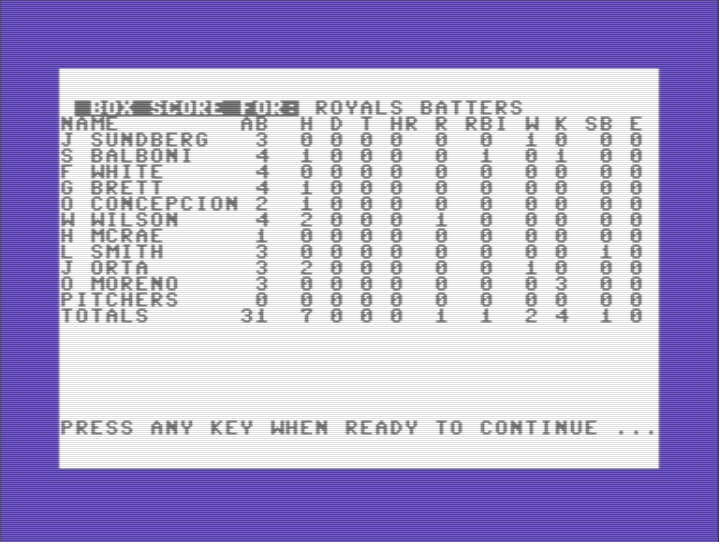
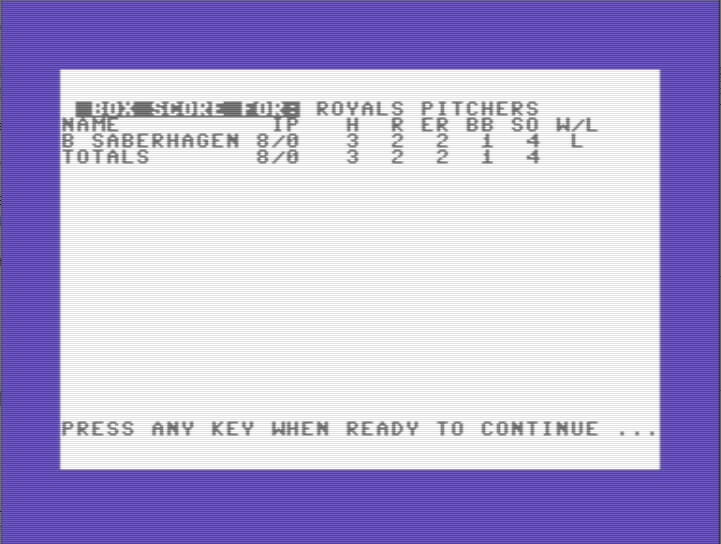
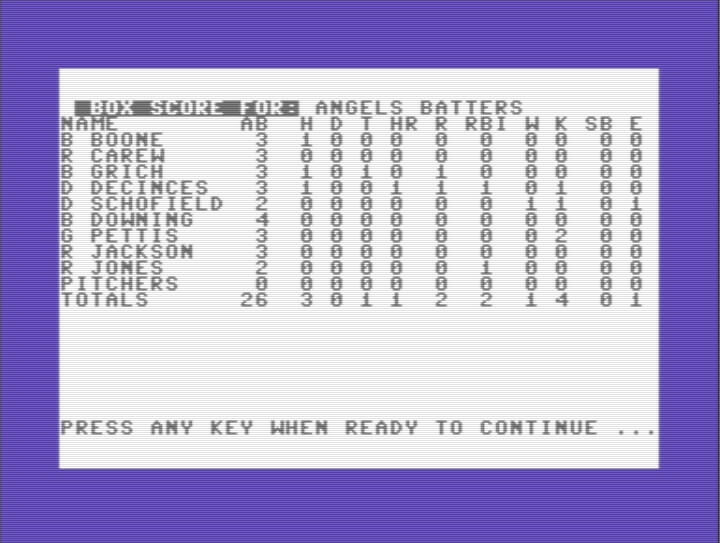
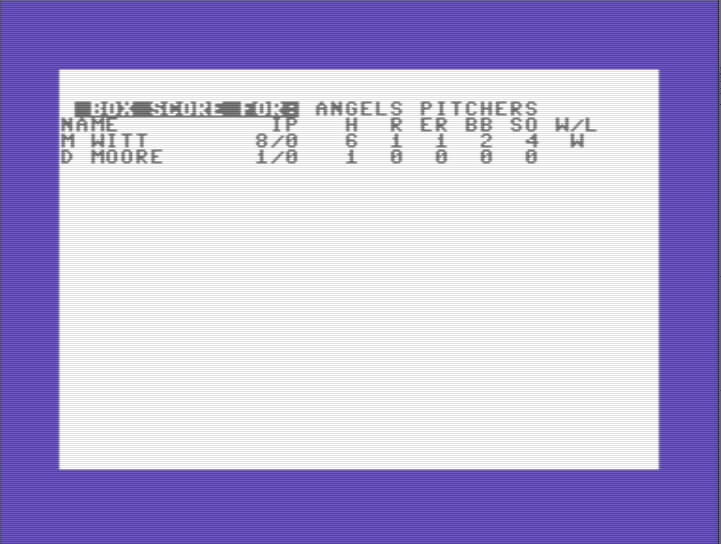
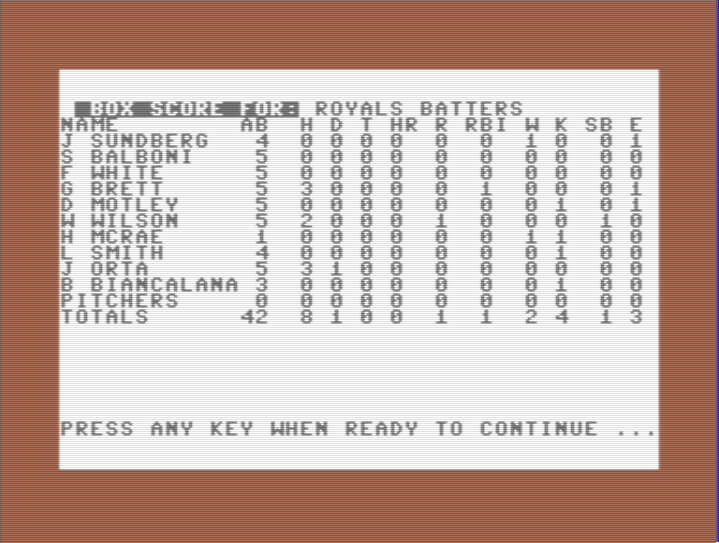
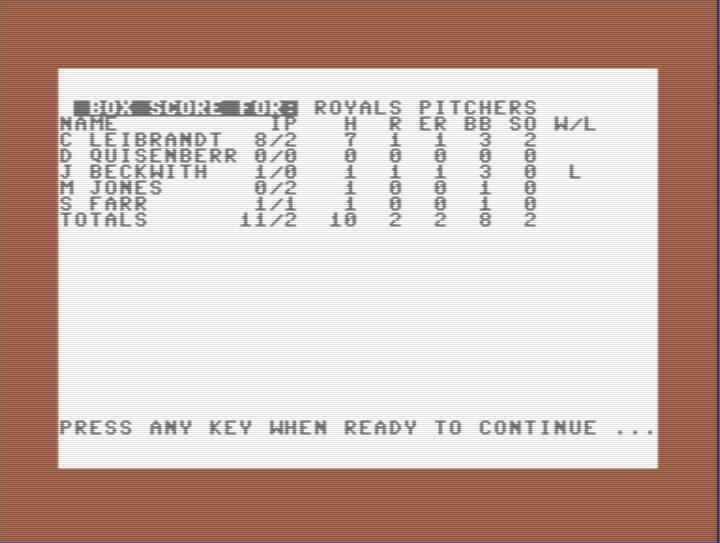
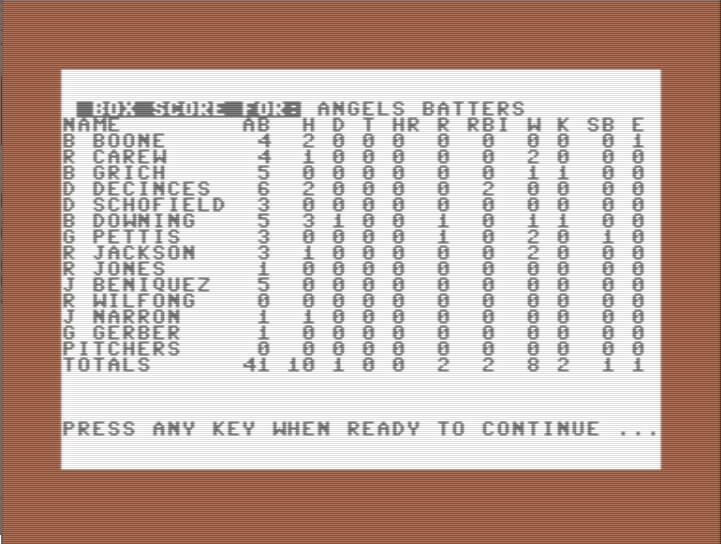

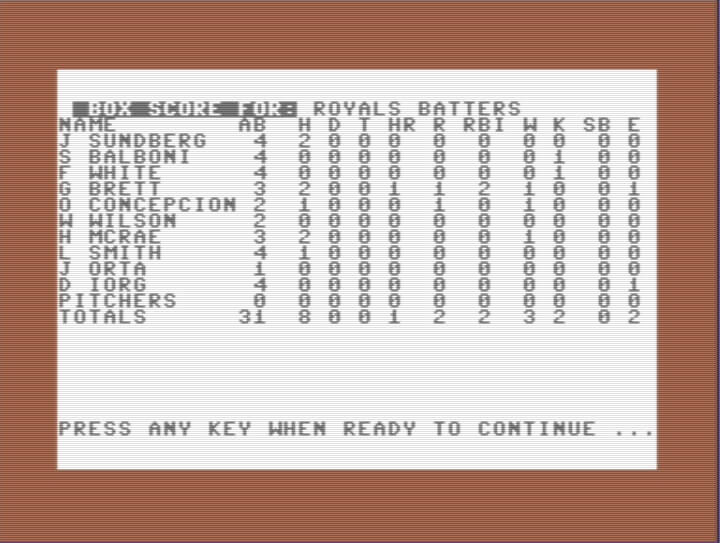
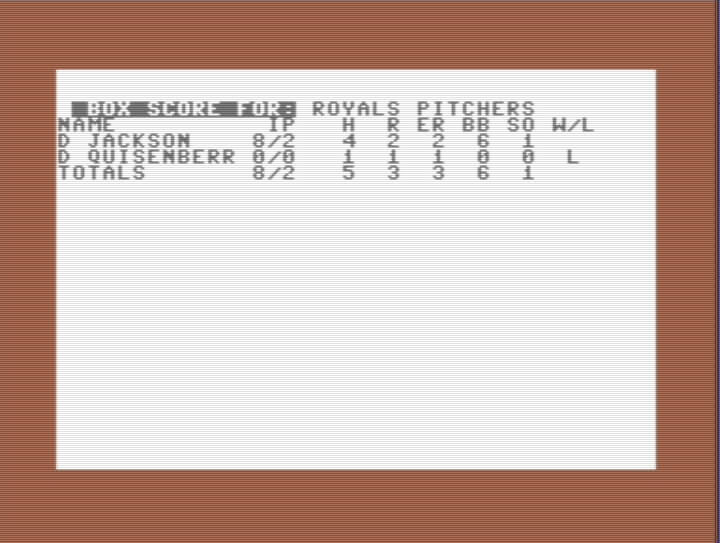
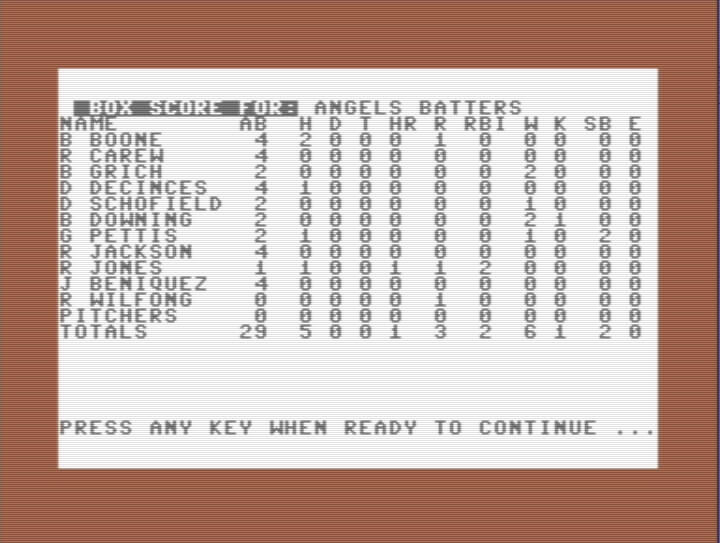
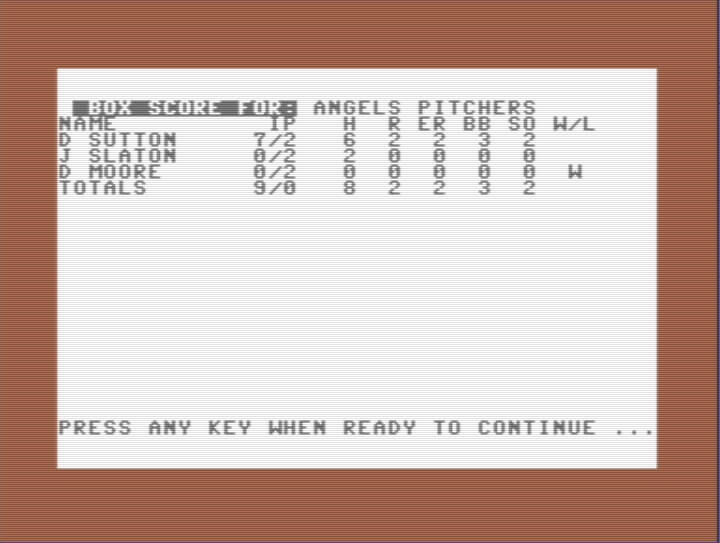
Articles in the Series
Additional Links
Play SSI Computer Baseball in your browser! – https://archive.org/details/a2_Computer_Baseball_1981_SSI_RDOS
Playthroughs – HardballRetro –
Oxner, Bill. “Play Ball.” Computer Gaming World, June-July 1985, Volume 5.3. pgs 24-25. http://www.cgwmuseum.org/galleries/issues/cgw_5.3.pdf
https://www.mobygames.com/game/computer-baseball
http://www.stadium64.com/gameinfos/computerbaseball/computerbaseball.htm
PDF version of the manual – SSI Computer Baseball manual
About the Author
Derek Bain is a New Jersey native with a passion for baseball, statistics, computers and video games who enjoys spending quality time with his family. Check out his “Hardball Retro” book series on Amazon along with numerous articles for Baseball Analytics, Fangraphs and Seamheads.
Hardball Architects – Volume 1 (American League)
Hardball Architects – Volume 2 (National League)
Hardball Retrospective – Addendum 2014 to 2016
NOTE: Original article posted on the Hardball Retro website, September 14, 2019.
The current article reflects revisions posted in July 2022:
- interview with game developer and founder of Strategic Simulations (SSI), Joel Billings
A lifelong resident of central New Jersey, I enjoy spending quality time with my wife and three children. In my professional life I’ve worked for three local healthcare systems as a server and network administrator over the last 30 years. Co-chair of the SABR Games and Simulations Committee since August 2022 along with Mark Wendling.
My hobbies include baseball, statistics, computers and video games along with freshwater fishing. I have authored five books and contributed articles to Seamheads, Fangraphs and my site, Hardball Retro. Follow my HardballRetro channels on Twitch for live-streaming of classic and current baseball video games and view the resulting playthrough videos on YouTube!
Visit my Amazon author page to check out my books, promotional videos, and post a review if you're a Hardball Retro fan!
My Books:
"Hardball Retro’s Compendium of Baseball Video Games and Electronic Handhelds," published in September 2024 with co-author John Racanelli, is available in paperback and digital (Kindle) format at Amazon.com.Hardball Retro’s Compendium of Baseball Video Games and Electronic Handhelds was recognized with the 2025 Sporting News-SABR Baseball Research Award.
“Hardball Architects – Volume 1 (American League Teams)”,published in July 2020, is available in paperback and digital (Kindle) format at Amazon.com.
“Hardball Architects – Volume 2 (National League Teams)”,published in April 2022, is available in paperback and digital (Kindle) format at Amazon.com.
“Hardball Architects” examines the trades, free agent acquisitions, draft picks and other transactions for the 30 Major League Baseball franchises, divided into a 2-volume set (American League and National League). All key moves are scrutinized for every team and Sabermetric principles are applied to the roster construction throughout the lifetime of the organization to encapsulate the hits and misses by front office executives.
“Hardball Retroactive”,published in June 2018, is available in paperback and digital (Kindle) format at Amazon.com. A cross-section of essays that I penned for Seamheads.com along with my Baseball Analytics blog spanning nearly a decade touching on subjects including "Taking the Extra Base", "General Manager Scorecard", "Worst Trades", "BABIP By Location" and "Baseball Birthplaces and the Retro World Baseball Classic". Rediscover your favorite hardball arcade and simulations in "Play Retro Baseball Video Games In Your Browser" or take a deep dive into every franchise's minor league successes and failures in relation to their major league operations in "Minors vs. Majors".
“Hardball Retrospective” is available in paperback and digital (Kindle) format at Amazon.com.Supplemental Statistics, Charts and Graphs along with a discussion forum are offered at TuataraSoftware.com. In Hardball Retrospective, I placed every ballplayer in the modern era (from 1901-present) on their original teams. Using a variety of advanced statistics and methods, I generated revised standings for each season based entirely on the performance of each team’s “original” players. I discuss every team’s “original” players and seasons at length along with organizational performance with respect to the Amateur Draft (or First-Year Player Draft), amateur free agent signings and other methods of player acquisition. Season standings, WAR and Win Shares totals for the “original” teams are compared against the real-time or “actual” team results to assess each franchise’s scouting, development and general management skills.
Don Daglow (Intellivision World Series Major League Baseball, Earl Weaver Baseball, Tony LaRussa Baseball) contributed the foreword for Hardball Retrospective. The foreword and preview of my book are accessible here.
“Hardball Retrospective - Addendum 2014 to 2016”supplements my research for Hardball Retrospective, providing retroactive standings based on Wins Above Replacement (WAR) and Win Shares (WS) for each "original" team over the past three seasons (2014-2016). Team totals from 2010 - 2013 are included for reference purposes. “Addendum” is available in paperback and digital (Kindle) format at Amazon.com.
Contact me on BlueSky - @hardballretro.bsky.social
- Derek Bainhttps://sabrbaseballgaming.com/author/dbain21/
- Derek Bainhttps://sabrbaseballgaming.com/author/dbain21/
- Derek Bainhttps://sabrbaseballgaming.com/author/dbain21/
- Derek Bainhttps://sabrbaseballgaming.com/author/dbain21/
